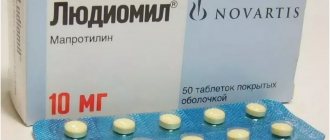Anafranil tablet p/o 25 mg N30 (Novartis)
It is known that tricyclic antidepressants reduce the threshold for convulsive readiness, therefore Anafranil should be used with extreme caution in patients with epilepsy, as well as in the presence of other factors predisposing to the occurrence of convulsive syndrome, for example, brain damage of any etiology, while using antipsychotic drugs, during the period of withdrawal from alcohol or withdrawal from drugs that have anticonvulsant properties (for example, benzodiazepines). It is believed that the occurrence of seizures while taking Anafranil depends on the dose of the drug. In this regard, you should not exceed the recommended daily dose of Anafranil. Anafranil should be prescribed with extreme caution to patients with cardiovascular diseases, especially cardiovascular failure, intracardiac conduction disorders (for example, AV block I-III degrees) or arrhythmias. In such patients, as well as in elderly patients, it is necessary to regularly monitor heart function and ECG. Before starting Anafranil therapy, it is recommended to measure blood pressure, since patients with orthostatic hypotension or lability of the cardiovascular system may experience a sharp decrease in blood pressure. Because the drug has anticholinergic properties, it should be used with extreme caution in patients with a history of increased intraocular pressure, angle-closure glaucoma, or urinary retention (for example, due to prostate disease). Due to the anticholinergic action characteristic of tricyclic antidepressants, there may be a decrease in tear production and accumulation of mucous secretion, which can lead to damage to the corneal epithelium in patients using contact lenses. Caution is necessary when treating patients with severe liver disease with tricyclic antidepressants, as well as in patients with tumors of the adrenal medulla (for example, pheochromocytoma, neuroblastoma), since in this case these drugs can provoke the development of a hypertensive crisis. It is known that patients with cyclic affective disorders taking tricyclic antidepressants may develop manic or hypomanic states during the depressive phase. In such cases, it may be necessary to reduce the dose of Anafranil or discontinue it and prescribe antipsychotic therapy. After relief of these conditions, if indicated, treatment with Anafranil in low doses can be resumed. In predisposed patients and elderly patients, tricyclic antidepressants can provoke the development of drug-induced delirious psychoses, mainly at night. After discontinuation of the drug, these disorders disappear within a few days.
Anafranil®
Pharmacodynamic type of interaction
Blockers of adrenergic neuronal transmission.
Anafranil
can reduce or completely eliminate the antihypertensive effect of guanethidine, betanidine, reserpine, clonidine and alphamethyldopa.
Therefore, in cases where treatment of arterial hypertension is required simultaneously with taking Anafranil
, drugs of other classes (for example, vasodilators or beta-blockers) should be used.
Anticholinergics.
Tricyclic antidepressants can enhance the effect of anticholinergic drugs (for example, phenothiazines, antiparkinsonian drugs, atropine, biperiden, antihistamines) on the organ of vision, the central nervous system, intestines and bladder.
CNS depressants.
Tricyclic antidepressants may enhance the effects of alcohol and other drugs that have a depressant effect on the central nervous system (for example, barbiturates, benzodiazepines or anesthetics). It should be borne in mind that alcohol can increase adverse effects from the central nervous system, such as blurred vision, drowsiness, etc.
MAO inhibitors.
Anafranil
should not be prescribed for at least 2 weeks after discontinuation of MAO inhibitors due to the risk of developing severe symptoms and conditions such as hypertensive crisis, fever, as well as symptoms of serotonin syndrome: myoclonus, agitation, convulsions, delirium and coma.
The same rule should be followed if a MAO inhibitor is prescribed after previous treatment with Anafranil
.
In any of these cases, the initial doses Anafranil
or MAO inhibitors should be low and should be increased gradually, under constant monitoring of the effects of the drug.
Current experience shows that Anafranil
can be prescribed no earlier than 24 hours after discontinuation of reversible MAO-A inhibitors, such as moclobemide. But, if a reversible MAO-A inhibitor is prescribed after Anafranil is discontinued, the duration of the break should be at least 2 weeks.
Selective serotonin reuptake inhibitors.
The combined use
of Anafranil
with these drugs can lead to an increased effect on the serotonin system.
Serotonergic agents.
With simultaneous use of
Anafranil
with selective serotonin reuptake inhibitors or serotonin and norepinephrine reuptake inhibitors, tricyclic antidepressants and lithium preparations, the development of serotonin syndrome with symptoms such as fever, myoclonus, agitation, convulsions, delirium and coma is possible.
If it is necessary to prescribe fluoxetine, it is recommended to take a two to three week break between the use of Anafranil
and fluoxetine - stop using fluoxetine 2-3 weeks before starting
Anafranil
or prescribe fluoxetine 2-3 weeks after finishing
Anafranil
.
Sympathomimetic agents.
Anafranil
can enhance the effect on the cardiovascular system of epinephrine, norepinephrine, isoprenaline, ephedrine and phenylephrine (including when these substances are part of local anesthetics).
Pharmacokinetic type of interaction
The active substance of the drug Anafranil
- clomipramine - mainly excreted in the form of metabolites. The main route of metabolism is demethylation to the active metabolite N-desmethylclomipramine, followed by hydroxylation and conjugation of N-desmethylclomipramine with clomipramine. Several isoforms of cytochrome P450 are involved in demethylation, mainly CYP3A4, CYP2C19 and CYP1A2. Elimination of both active components occurs through hydroxylation, which is catalyzed by CYP2D6.
Co-administration with inhibitors of the CYP2D6 isoform can lead to an increase in the concentrations of both active components by up to three times in individuals with the rapid debrisoquine/sparteine acetylator phenotype. At the same time, in these patients, metabolism decreases to a level characteristic of individuals with the slow acetylator phenotype. It is expected that co-administration with inhibitors of the CYP1A2, CYP2C19 and CYP3A4 isoforms may lead to an increase in the concentration of clomipramine and a decrease in the concentration of N-desmethylclomipramine.
MAO inhibitors (eg moclobemide) are contraindicated when taking clomipramine, since in vivo
they are strong inhibitors of CYP2D6.
Antiarrhythmic drugs (eg quinidine and propafenone) should not be used in conjunction with tricyclic antidepressants, as they are strong inhibitors of CYP2D6.
Selective serotonin reuptake inhibitors (such as fluoxetine, paroxetine or sertraline) inhibit CYP2D6, other drugs of this group (for example fluvoxamine) also inhibit CYP1A2, CYP2C19, which can lead to an increase in plasma concentrations of clomipramine and the development of corresponding undesirable effects. A 4-fold increase in the equilibrium concentration of clomipramine was observed when taken together with fluvoxamine (the concentration of N-desmethylclomipramine decreased by 2 times).
Concomitant use of antipsychotics (eg phenothiazines) may lead to increased plasma concentrations of tricyclic antidepressants, a decrease in the seizure threshold and the occurrence of seizures. Combination with thioridazine can lead to the development of severe heart rhythm disturbances.
Combined use with the histamine (H2) receptor blocker cimetidine (which is an inhibitor of some isoforms of cytochrome P450, including CYP2D6 and CYP3A4) may lead to an increase in plasma concentrations of tricyclic antidepressants, which requires a reduction in the dose of the latter.
There is no data confirming the interaction between Anafranil
(at a dose of 25 mg per day) and oral contraceptives (15 or 30 mcg ethinyl estradiol per day) with constant use of the latter. There is no evidence that estrogens are inhibitors of CYP2D6, the main enzyme involved in the elimination of clomipramine, so there is no reason to expect their interaction. Although, with the simultaneous use of the tricyclic antidepressant imipramine and estrogens in high doses (50 mcg per day), in some cases, worsening side effects and an increase in the therapeutic effect of the antidepressant have been reported. It is unknown whether these data are significant with respect to the concomitant use of clomipramine and low-dose estrogens. When using tricyclic antidepressants and estrogens in high doses (50 mcg per day) together, it is recommended to monitor the therapeutic effect of antidepressants and, if necessary, adjust the dosage regimen.
Methylphenidate (Ritalin) may increase concentrations of tricyclic antidepressants, possibly by inhibiting their metabolism. When using these drugs together, it is possible to increase the concentration of tricyclic antidepressants in the blood plasma, and it may be necessary to reduce the dose of the latter.
Some tricyclic antidepressants may enhance the anticoagulant effects of coumarins (eg, warfarin), possibly by inhibiting their metabolism (CYP2C9). There is no data proving the ability of clomipramine to inhibit the metabolism of anticoagulants (warfarin). However, monitoring of plasma prothrombin concentrations is recommended when using this class of drugs.
Joint use of Anafranil
with drugs that are inducers of cytochrome P450, especially CYP3A4, CYP2C19 and/or CYP1A2, can lead to increased metabolism and reduce the effectiveness
of Anafranil
.
Joint use of Anafranil
with drugs that induce CYP3A and CYP2C, such as rifampicin or irotivoconvulsant drugs (for example, barbiturates, carbamazepine, phenobarbital and phenytoin), may lead to a decrease in plasma concentrations of clomipramine.
Known CYP1A2 inducers (eg nicotine/other components of cigarette smoke) reduce plasma concentrations of tricyclic antidepressants. The steady-state concentration of clomipramine in cigarette smokers is 2 times lower than that in non-smokers (the concentration of N-desmethylclomipramine did not change).
Clomipramine as in vivo
, and
in vitro
(Ki=2.2 microM), inhibits the activity of CYP2D6 (sparteine oxidation). Thus, clomipramine may increase concentrations of concomitantly administered drugs metabolized primarily by CYP2D6 in individuals with a rapid acetylator phenotype.
Pharmaceutical incompatibility.
Solution for injection is incompatible with Voltaren (diclofenac sodium) solution for injection.
Anafranil
Use during pregnancy and breastfeeding
Experience with the use of Anafranil during pregnancy is limited.
Since there are isolated reports of a possible connection between the use of tricyclic antidepressants and fetal developmental disorders, the use of Anafranil during pregnancy should be avoided, unless the expected effect of treatment on the mother clearly outweighs the potential risk to the fetus. In cases where tricyclic antidepressants were used during pregnancy until delivery, the neonate developed a withdrawal syndrome within the first few hours or days, manifested by shortness of breath, drowsiness, colic, irritability, hypotension or hypertension, tremor, cramping, or convulsions. To avoid the development of this syndrome, Anafranil should be gradually withdrawn, if possible, at least 7 weeks before the expected birth.
Since the active substance of the drug is excreted in breast milk, you should either stop breastfeeding or gradually discontinue Anafranil.
Use for liver dysfunction
In patients with liver disease, periodic monitoring of liver enzyme activity is recommended.
Caution is necessary when treating patients with severe liver disease with tricyclic antidepressants, as well as in patients with tumors of the adrenal medulla (for example, pheochromocytoma, neuroblastoma), since in this case these drugs can provoke the development of a hypertensive crisis.
Use in children
The drug is not recommended for use in children under 5 years of age.
Use in elderly patients
Anafranil should be prescribed with extreme caution to patients with cardiovascular diseases, especially cardiovascular failure, intracardiac conduction disorders (for example, AV block I-III degrees) or arrhythmias. In such patients, as well as in elderly patients, it is necessary to regularly monitor heart function and ECG.
Caution is required when using Anafranil in patients with chronic constipation. Tricyclic antidepressants can cause paralytic ileus, mainly in elderly patients or in patients who are forced to remain in bed.
special instructions
It is known that tricyclic antidepressants reduce the threshold for convulsive readiness, therefore Anafranil should be used with extreme caution in patients with epilepsy, as well as in the presence of other factors predisposing to the occurrence of convulsive syndrome, for example, brain damage of any etiology, while using antipsychotic drugs, during the period of withdrawal from alcohol or withdrawal from drugs that have anticonvulsant properties (for example, benzodiazepines). It is believed that the occurrence of seizures while taking Anafranil depends on the dose of the drug. In this regard, you should not exceed the recommended daily dose of Anafranil.
Anafranil should be prescribed with extreme caution to patients with cardiovascular diseases, especially cardiovascular failure, intracardiac conduction disorders (for example, AV block I-III degrees) or arrhythmias. In such patients, as well as in elderly patients, it is necessary to regularly monitor heart function and ECG.
Before starting Anafranil therapy, it is recommended to measure blood pressure, since patients with orthostatic hypotension or lability of the cardiovascular system may experience a sharp decrease in blood pressure.
Because the drug has anticholinergic properties, it should be used with extreme caution in patients with a history of increased intraocular pressure, angle-closure glaucoma, or urinary retention (for example, due to prostate disease).
Due to the anticholinergic action characteristic of tricyclic antidepressants, there may be a decrease in tear production and accumulation of mucous secretion, which can lead to damage to the corneal epithelium in patients using contact lenses.
Caution is necessary when treating patients with severe liver disease with tricyclic antidepressants, as well as in patients with tumors of the adrenal medulla (for example, pheochromocytoma, neuroblastoma), since in this case these drugs can provoke the development of a hypertensive crisis.
It is known that patients with cyclic affective disorders taking tricyclic antidepressants may develop manic or hypomanic states during the depressive phase. In such cases, it may be necessary to reduce the dose of Anafranil or discontinue it and prescribe antipsychotic therapy. After relief of these conditions, if indicated, treatment with Anafranil in low doses can be resumed.
In predisposed patients and elderly patients, tricyclic antidepressants can provoke the development of drug-induced delirious psychoses, mainly at night. After discontinuation of the drug, these disorders disappear within a few days.
Caution should be exercised when treating patients with hyperthyroidism or receiving thyroid hormone medications, which may have cardiotoxic effects.
Although changes in white blood cell levels during treatment with Anafranil have been reported only in isolated cases, periodic examination of peripheral blood composition and attention to symptoms such as fever and sore throat are recommended, especially in the first months of therapy or with long-term use of the drug.
Caution is required when using Anafranil in patients with chronic constipation. Tricyclic antidepressants can cause paralytic ileus, mainly in elderly patients or in patients who are forced to remain in bed.
When using Anafranil in doses exceeding the average therapeutic one, or if the concentration of clomipramine in plasma exceeds the average therapeutic one, there is a risk of prolongation of the QTc interval and the occurrence of bidirectional fusiform ventricular tachycardia (ventricular disturbances). This occurs when taken together with selective serotonin reuptake inhibitors or serotonin-norepinephrine reuptake inhibitors. In this regard, it is necessary to avoid co-administration of clomipramine and drugs that cause its accumulation. It is also necessary to avoid co-administration with drugs that cause prolongation of the QTc interval. The use of diuretics can lead to the development of hypokalemia. It has been established that hypokalemia is a risk factor for prolongation of the QTc interval and the occurrence of bidirectional fusiform ventricular tachycardia (ventricular disorders). Therefore, hypokalemia must be eliminated before starting Anafranil therapy. Anafranil should be used with caution concomitantly with selective serotonin reuptake inhibitors or serotonin-norepinephrine reuptake inhibitors, as well as with diuretics.
Due to the risk of serotonin toxicity, the recommended dosage should be adhered to and the dose should be increased with caution if Anafranil is used concomitantly with serotonergic drugs.
With simultaneous use of Anafranil with serotonergic drugs, such as selective serotonin reuptake inhibitors, serotonin and norepinephrine reuptake inhibitors, tricyclic antidepressants or lithium preparations, the development of serotonin syndrome with symptoms such as fever, myoclonus, agitation, convulsions, delirium and coma is possible. . If it is necessary to prescribe fluoxetine, it is recommended to take a two to three week break between the use of Anafranil and fluoxetine.
Many patients with panic disorders experience increased anxiety at the beginning of treatment with Anafranil. This paradoxical increase in anxiety is most pronounced in the first days of therapy and usually subsides within two weeks.
In patients with schizophrenia receiving tricyclic antidepressants, activation of psychosis is sometimes observed.
In patients with liver disease, periodic monitoring of liver enzyme activity is recommended.
Anafranil, like other tricyclic antidepressants, is prescribed in combination with electroconvulsive therapy only under close medical supervision.
Severe depression is characterized by a risk of suicidal actions, which can persist until reliable remission is achieved. Patients with depression, both adults and children, may experience increased depression and/or suicidal behavior or other psychiatric symptoms, whether or not they are receiving antidepressant therapy. Antidepressants increased the risk of suicidal ideation and behavior in short-term studies in children and adolescents with depression and other psychiatric illnesses.
All patients taking Anafranil for any indication should be monitored for worsening clinical symptoms, suicidal behavior and other psychiatric symptoms, especially during the initial phase of therapy or when the dose of the drug is changed. In such patients, changes in the treatment regimen, including possible discontinuation of the drug, should be considered, especially if such changes are pronounced, appeared suddenly, or were not observed in the patients initially.
Families and caregivers of patients (both children and adults) taking antidepressants for psychiatric or non-psychiatric indications should be warned to monitor patients due to the risk of other psychiatric symptoms, including and suicidal behavior, and immediately report such symptoms to your healthcare provider.
When writing a prescription for Anafranil, the minimum number of tablets should be specified to reduce the risk of overdose. In this case, it is necessary to follow an adequate treatment regimen.
There is evidence that while taking Anafranil, there is a lower number of deaths due to overdose than when taking other tricyclic antidepressants.
Before performing general or local anesthesia, the anesthesiologist should be warned that the patient is taking Anafranil.
An increased incidence of dental caries has been reported with long-term treatment with tricyclic antidepressants. Therefore, in case of long-term therapy with Anafranil, regular examination of the patient by a dentist is recommended.
The use of diuretics can lead to the development of hypokalemia, which increases the risk of prolongation of the QTc interval and the occurrence of bidirectional fusiform ventricular tachycardia (pirouette type). Before starting Anafranil therapy, hypokalemia must be corrected.
Abrupt withdrawal of Anafranil should be avoided, because this may lead to adverse reactions. If a decision is made to discontinue treatment, the drug should be withdrawn gradually, as quickly as the clinical situation allows. It should be borne in mind that abrupt withdrawal of the drug may be accompanied by the development of certain symptoms.
25 mg film-coated tablets contain lactose and sucrose. Patients with rare hereditary diseases such as galactose and fructose intolerance, severe lactase deficiency, sucrase-isomaltase deficiency or glucose-galactose malabsorption should not take Anafranil film-coated tablets.
It should be borne in mind that alcohol can increase adverse effects from the central nervous system, such as blurred vision and drowsiness.
Use in pediatrics
There is no experience with the use of Anafranil in children under 5 years of age, therefore it is not recommended to use the drug in children of this age group.
Impact on the ability to drive vehicles and operate machinery
Patients who experience drowsiness and other central nervous system disorders (including blurred vision) while taking Anafranil should not drive a car, operate machinery, or engage in other activities that require increased attention and quick reaction.



